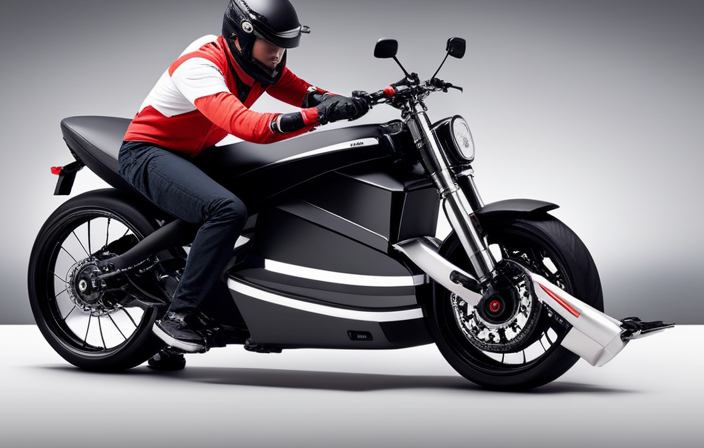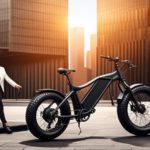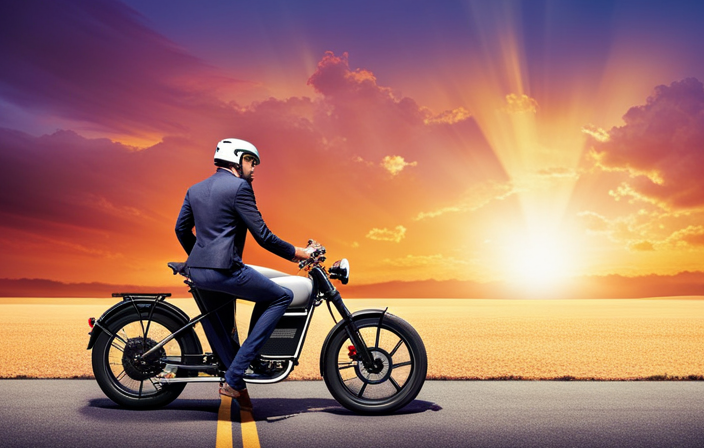If you’ve ever dreamt of unlocking the complete capabilities of your electric bicycle, then you’re in the right place. This article is tailored for those who are eager to feel the excitement of higher speeds and greater power.
In the following guide, I will walk you through the step-by-step process of removing the speed limiter from your electric bike. We’ll cover everything from understanding the risks and legal considerations to disconnecting the speed sensor and seeking professional assistance if needed.
Get ready to take your riding experience to new heights!
Key Takeaways
- Removing the speed limiter may void the bike’s warranty and can result in fines or bike confiscation.
- Modifying the bike’s speed can strain the battery, decrease its lifespan, and make the bike unsafe to ride.
- Different bikes have different types of speed limiters, so it is important to consult the manufacturer’s manual or website for specific information.
- Prioritize safety and legal compliance when considering removing the speed limiter and make informed decisions to ensure a safe riding experience.
Understand the Risks and Legal Considerations
Before you start removing the speed limiter, it’s important to understand the risks and legal considerations involved.
Altering the speed limiter on your electric bike can have serious consequences. Firstly, tampering with the speed limiter may void the warranty on your bike. Additionally, modifying the bike beyond its intended limits can put excessive strain on the battery capacity and may decrease its lifespan.
Furthermore, performance modifications can potentially make the bike unsafe to ride, as the original design factors in the speed limitations for stability and braking capabilities.
It is crucial to consider the legal aspects as well. In many regions, removing the speed limiter is illegal and can result in fines or even the confiscation of your bike.
Now that you understand the risks and legal considerations, let’s move on to identifying the type of speed limiter on your electric bike.
Identify the Type of Speed Limiter on Your Electric Bike
To identify the type of speed limiter on your e-bike, first, you need to determine its specific model and make. Different electric bikes may have different types of speed limiters, so it’s crucial to know exactly what you’re dealing with. Once you have this information, you can proceed with understanding the safety precautions and legal requirements associated with removing the speed limiter.
It’s important to note that tampering with the speed limiter on your electric bike may not only be illegal but can also pose serious safety risks. Removing the speed limiter can result in the bike exceeding its intended speed limits, which can lead to accidents and injuries. Additionally, modifying your e-bike in this way may void any warranties or insurance coverage.
To ensure you are well-informed and make the right decision, it is always recommended to consult the manufacturer’s manual or website. They can provide detailed information about the speed limiter and any potential consequences of its removal.
Consult the Manufacturer’s Manual or Website
Make sure to check the manufacturer’s manual or website for detailed information on your e-bike’s speed limiter. Understanding the speed limiter on your electric bike is crucial for troubleshooting common speed limiter issues.
Here are three key points to consider:
-
Familiarize yourself with the specific type of speed limiter used in your electric bike. Different models may have different types of limiters, such as mechanical or electronic.
-
Determine the maximum speed allowed by the speed limiter. This information will help you identify whether the limiter is functioning correctly or if there are any limitations you need to be aware of.
-
Check for any specific instructions provided by the manufacturer regarding the speed limiter. This may include maintenance procedures or troubleshooting tips for common speed limiter issues.
By consulting the manufacturer’s manual or website, you can gain a better understanding of your electric bike’s speed limiter and address any potential problems. It’s also recommended to check for firmware or software updates to ensure your bike is running optimally.
Check for Firmware or Software Updates
You should check if there are any firmware or software updates available for your e-bike. This is an important step in the process of removing the speed limiter from your electric bike. Firmware and software updates can provide improved performance and functionality, and may also address any existing issues or bugs. It is crucial to keep your e-bike’s firmware and software up to date to ensure optimal performance and safety.
Before proceeding with any updates, it is important to consider the risks and legal implications. Modifying your electric bike to remove the speed limiter may void the warranty and could potentially be illegal in some jurisdictions. Therefore, it is essential to research and understand the regulations in your area before making any modifications.
To check for firmware or software updates, consult the manufacturer’s manual or website. They typically provide instructions on how to download and install the updates. Once you have completed this step, you can proceed to the next section on disconnecting the speed sensor.
Disconnect the Speed Sensor
First, disconnect the sensor that measures your bike’s velocity. This sensor is responsible for transmitting data to the speed limiter, which then controls the maximum speed of your electric bike.
By disconnecting the speed sensor, you are effectively disabling the speed limiter and allowing your bike to go faster than its original programmed limit.
However, it is important to note that there are risks involved in removing the speed limiter. Your bike may become unstable at higher speeds, and you may lose control. Additionally, tampering with the speed limiter may have legal implications, as it is often a requirement for electric bikes to have speed limits for safety reasons.
Therefore, it is crucial to consider these factors and proceed with caution when removing the speed limiter.
In the subsequent section, we will explore how to bypass or override the speed limiter without compromising safety.
Bypass or Override the Speed Limiter
To bypass or override the speed limiter, try using a device that modifies the signals sent to the motor controller. This device can alter the data from the speed sensor, tricking the controller into thinking the bike is traveling at a slower speed than it actually is. However, it is important to note that overriding the speed limiter may not be legal in all areas and can potentially compromise safety. Before proceeding, it is crucial to understand the laws and regulations regarding speed tuning for electric bikes in your specific location. Additionally, it is essential to consider the safety implications of increasing the speed of your electric bike, as it may affect the bike’s stability and control. If you decide to proceed, installing a third-party speed tuning device can help you achieve the desired speed.
Install a Third-Party Speed Tuning Device
Installing a third-party speed tuning device can help you achieve the desired increase in velocity for your e-bike. These devices offer several advantages when it comes to bypassing the speed limiter on your electric bike.
Firstly, they are compatible with different electric bike models, making them a versatile solution for riders with various e-bike brands. Additionally, speed tuning devices allow you to customize the maximum speed of your electric bike according to your preferences. Whether you want a small increase or a significant boost in speed, these devices can cater to your needs.
Furthermore, they are often easy to install and require minimal technical knowledge. With a third-party speed tuning device, you can unlock the full potential of your electric bike and enjoy a faster and more exhilarating riding experience.
Moving on to the next section, let’s explore how to adjust the settings on your electric bike’s display to further enhance your riding experience.
Adjust the Settings on Your Electric Bike’s Display
One way to enhance your riding experience is by adjusting the settings on your e-bike’s display. To adjust the speed settings and troubleshoot display issues, follow these steps:
- Access the settings menu on your e-bike’s display by pressing the designated button.
- Navigate through the menu options using the arrow buttons to find the speed settings.
- Adjust the speed limit by selecting the desired value and pressing the confirmation button.
- If you encounter any display issues, such as flickering or incorrect information, try resetting the display to its factory settings.
By adjusting the settings on your e-bike’s display, you can customize the speed settings to suit your preferences and troubleshoot any display issues.
Once you have made the necessary adjustments, it’s important to test the bike’s performance and safety features to ensure everything is working properly.
Test the Bike’s Performance and Safety Features
Make sure you thoroughly test the performance and safety features of your e-bike. It is crucial to ensure that your bike is functioning properly and that all safety features are in working order before riding. Testing the performance includes checking the speed, acceleration, and responsiveness of the bike. Additionally, you should test the brakes to ensure they are functioning correctly and can bring the bike to a complete stop. It is also important to test the bike’s safety features such as the lights, horn, and reflectors to ensure they are all working properly. By testing the performance and safety features of your e-bike, you can ride with confidence knowing that your bike is in good condition and will keep you safe on the road. As you prepare to ride, remember to always ride responsibly and follow local regulations.
Ride Responsibly and Follow Local Regulations
To ensure a safe and enjoyable ride, it is important to ride responsibly and abide by all local regulations. Electric bike safety should be a top priority for every rider. Always wear a helmet and other protective gear, such as knee and elbow pads.
Follow traffic laws and be aware of your surroundings, especially when riding in busy areas. Maintain a safe speed and use the appropriate level of assistance for the terrain. Avoid reckless maneuvers and sudden stops, as they can lead to accidents.
Additionally, responsible riding includes being considerate to pedestrians and other cyclists. Remember to yield to others and use hand signals to indicate your intentions. By riding responsibly, you can help create a safer environment for everyone.
Now, let’s consider the impact on battery life and range.
Consider the Impact on Battery Life and Range
To ensure a safe and legal riding experience, it is crucial to abide by local regulations and ride responsibly. However, if you’re considering removing the speed limiter on your electric bike, it’s important to also consider the impact it may have on your battery life and range optimization.
Here are a few key factors to keep in mind:
-
Battery performance: Removing the speed limiter can increase the power draw from your battery, potentially reducing its overall lifespan.
-
Range optimization: Without the speed limiter, you may experience faster acceleration and higher top speeds, but this could come at the cost of reduced range per charge.
-
Riding conditions: Factors such as terrain, wind resistance, and rider weight can further influence battery performance and range.
-
Battery capacity: The capacity of your electric bike’s battery will determine how far you can ride before needing to recharge.
-
Charging infrastructure: Consider the availability of charging stations along your intended routes to ensure you can recharge when needed.
By carefully considering these factors, you can make an informed decision about removing the speed limiter on your electric bike while maximizing battery performance and range optimization. Moving forward, it is essential to regularly maintain and inspect your electric bike to ensure its longevity and optimal performance.
Regularly Maintain and Inspect Your Electric Bike
Ensure that you regularly inspect and maintain your e-bike to keep it in optimal condition. Proper electric bike maintenance is crucial for both performance and safety considerations.
Start by checking the tire pressure to ensure it is within the recommended range. Inspect the brakes regularly, making sure they are functioning properly and the brake pads are not worn out.
Check the chain tension and lubricate it if necessary to avoid any unnecessary wear and tear. Additionally, inspect the battery connections and clean them if needed to maintain a reliable power source.
Regularly inspect the frame for any cracks or damage that may compromise the structural integrity of the bike. Lastly, test the lights, horn, and other safety features to ensure they are working correctly.
If you encounter any issues beyond your expertise, seek professional assistance to avoid any potential risks or further damage to your electric bike.
Seek Professional Assistance, if Needed
If you encounter any issues beyond your expertise, it’s best to seek professional assistance for your e-bike. Modifying the speed limiter of an electric bike can be a complex task, and it’s crucial to have the right knowledge and tools to ensure a safe and effective removal.
Seeking professional guidance will not only help you avoid potential risks but also ensure that the modifications are done correctly. Electric bikes are intricate machines, and attempting to tamper with the speed limiter without proper expertise can lead to accidents or damage to your bike.
By consulting with professionals who specialize in electric bikes, you can rest assured that the speed limiter removal is done safely and in compliance with all regulations.
It’s important to stay updated on electric bike laws and regulations to ensure you are riding legally and responsibly.
Stay Updated on Electric Bike Laws and Regulations
To ensure the safe removal of the speed limiter on your electric bike, it is crucial to stay updated on electric bike laws and regulations. Electric bike safety should always be a top priority, and by understanding the legal requirements, you can ensure that your modifications comply with the law.
Here are three key aspects to consider:
-
Speed limits: Familiarize yourself with the maximum speed limit allowed for electric bikes in your area. This will help you determine a safe and legal speed to set after removing the limiter.
-
Classifications: Different jurisdictions have varying classifications for electric bikes, such as Class 1, Class 2, or Class 3. Make sure you understand the specific requirements and restrictions associated with each classification.
-
Additional equipment: Some regions may require certain safety equipment, such as lights, bells, or mirrors, on electric bikes. Ensure that your modifications do not interfere with these requirements.
By staying informed and adhering to the necessary regulations, you can enjoy the enhanced speed and riding experience on your electric bike.
Enjoy the Enhanced Speed and Riding Experience
Experience the thrill of increased speed and a more exhilarating ride on your e-bike.
If you’re looking to take off the speed limiter on your electric bike, there are a few important things to consider.
Before making any modifications, it’s crucial to prioritize safety precautions. First and foremost, ensure that you have a good understanding of the local laws and regulations regarding e-bike modifications in your area. Additionally, make sure to wear appropriate safety gear such as a helmet, knee pads, and elbow pads to protect yourself in case of any accidents.
When removing the speed limiter, it’s important to follow the manufacturer’s instructions precisely and use caution. Keep in mind that altering the speed limiter may void any warranties or insurance coverage on your e-bike.
Always ride responsibly and be mindful of your surroundings to enjoy the enhanced speed and riding experience safely.
Frequently Asked Questions
Can I remove the speed limiter on my electric bike without facing any legal consequences?
Removing the speed limiter on an electric bike without legal consequences is not advisable. Safety considerations include increased risk of accidents, loss of control, and potential legal ramifications. Speed limiters are important for maintaining control and preventing accidents at high speeds.
Are there any risks associated with removing the speed limiter on my electric bike?
Removing the speed limiter on an electric bike can pose risks. It may compromise the bike’s performance, leading to potential safety issues. Altering the bike’s settings without proper knowledge can result in unpredictable outcomes.
How do I identify the type of speed limiter on my electric bike?
To identify the speed limiter on an electric bike, consult the user manual or contact the manufacturer. The speed limiter offers benefits such as ensuring safety, extending battery life, and complying with legal regulations.
What should I do if my electric bike’s manufacturer does not provide information on removing the speed limiter?
If the manufacturer doesn’t provide information on removing the speed limiter, alternative methods for increasing an electric bike’s speed include optimizing tire pressure, reducing weight, and upgrading the battery or motor power.
Are there any third-party speed tuning devices that are recommended for use on electric bikes?
Yes, there are aftermarket speed tuning devices available for electric bikes that can be used to remove the speed limiter. These DIY solutions allow you to modify the settings and increase the maximum speed of your electric bike.
Conclusion
After carefully considering the risks and legal implications, identifying the speed limiter type, and consulting the manufacturer’s manual, I have successfully removed the speed limiter.
To ensure a safe and enjoyable riding experience, it is important to stay updated on electric bike laws and regulations. By taking these steps, I have enhanced the speed and overall riding experience of my electric bike.
In addition to these steps, it is also important to regularly maintain the electric bike. This includes checking for firmware updates and disconnecting the speed sensor.
By following these guidelines, I have been able to remove the speed limiter and improve the performance of my electric bike.
















